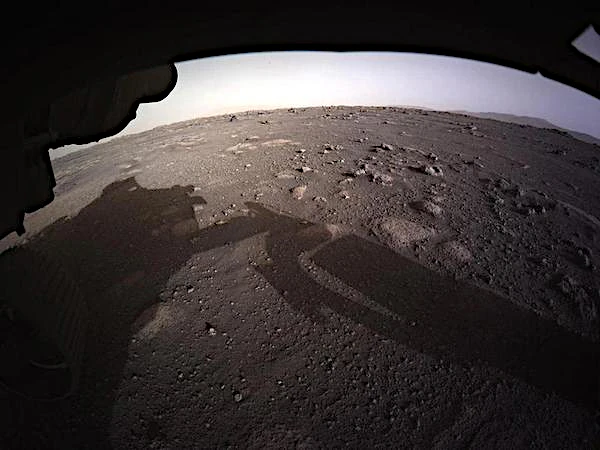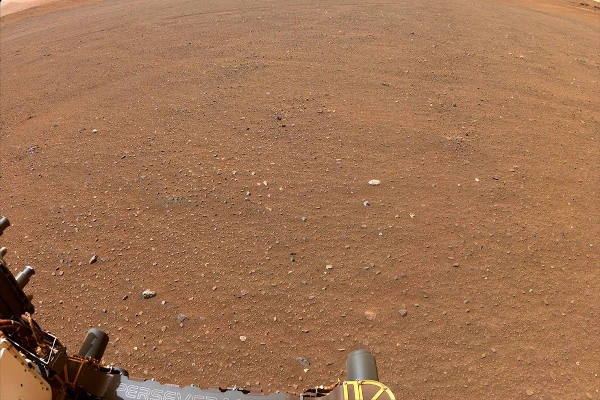
On February 18, 2021, the Perseverance rover from the Mars 2020 mission landed in Jezero Crater, a 45 km-wide ancient impact basin located in Mars' northern hemisphere. Just minutes after landing, it transmitted its first black-and-white images of the Martian surface, captured by the HazCam. Although rudimentary, these images marked a turning point: it was the first time an exploration robot sent such a clear view of the terrain of a Martian fossil delta.
The high-resolution images later taken by the NavCam and Mastcam-Z cameras revealed a complex rocky surface. There is an alternation of fine grains and angular pebbles, ranging in size from a few millimeters to several centimeters. This heterogeneity reflects varied geological processes: wind erosion, sedimentary deposits, and ancient water flows.
Spectroscopic analysis of the rocks showed signatures of olivine and pyroxene, two minerals typical of volcanic basalts. These data suggest that the Martian surface of Jezero has undergone a long volcanic history, followed by chemical alteration by aqueous fluids. The observed sediments may therefore have trapped traces of ancient organic molecules, the main objective of the mission.
Among the onboard instruments, the SHERLOC camera and the PIXL spectrometer play a key role in mineralogical and chemical analysis. By combining fluorescence and X-ray diffraction techniques, these devices can identify mineral phases at the micrometer scale.
The first results revealed the presence of iron oxides, responsible for the planet's characteristic red color. The porosity of the soil, measured from shadows and light scattering, indicates an average density of approximately \(\rho \approx 2.7\ g/cm^3\), comparable to that of terrestrial basalts.
These observations support the hypothesis that Jezero Crater once hosted a lake. The layers of sediment visible in the delta cliffs suggest successive deposits, likely formed by intermittent flows. This supports the models of John Grotzinger (1960-) and his team, according to which Mars experienced a wet phase during the Noachian period, about 3.8 billion years ago.
The albedo variations observed in the panoramic images also indicate differences in grain size and oxidation, reflecting ancient chemical activity between water and rocks. These clues fuel the search for biosignatures, i.e., structures or molecules that could indicate past life.

Bringing the samples collected by Perseverance back to Earth represents one of the most ambitious endeavors in the history of space exploration. Named MSR, this international program is jointly led by NASA and ESA. It aims to return, for the first time, authentic fragments of Martian soil and rocks to analyze them with the most precise terrestrial technologies.
The Mars Sample Return plan is based on a complex architecture with three main segments:
In orbit, a capture probe named ERO, developed by ESA, will intercept the capsule containing the samples before bringing it back to Earth in a controlled trajectory. The entire process requires extreme precision: launch windows, orbital synchronization, and interplanetary transfer mechanics must be calculated to the millimeter.
The return of extraterrestrial material raises questions of planetary protection. The samples will be enclosed in a double-sealed capsule to prevent any contamination, both Martian and terrestrial. Upon their arrival on Earth, scheduled for around 2033, they will be transferred to an ultra-secure laboratory comparable to those used for level 4 biological viruses.
Each sample will be analyzed in several steps: radiometric dating, isotopic study (\(^{87}\text{Sr}/^{86}\text{Sr}\), \(^{18}\text{O}/^{16}\text{O}\)), mass spectrometry, and electron microscopy. These measurements will help assess whether certain rocks have been altered by water or if mineral structures exhibit biologically plausible morphologies.
Institutions from around the world, such as the JPL, the CNES, and the ESA, are participating in the design of the return system. Engineers are drawing on experience from previous missions like OSIRIS-REx and Hayabusa2, which returned asteroid samples. This international cooperation illustrates the new era of robotic exploration: the convergence of planetary science, orbital engineering, and astrobiology.
The Martian cores collected by Perseverance are valuable geological archives. By studying their microscopic structures and isotopic composition, researchers hope to reconstruct the evolution of the Martian climate and determine if the planet was habitable. Any traces of organic matter or fossil biosignatures could revolutionize our understanding of life in the Solar System.
N.B.:
The Mars Sample Return program is designed to minimize the risk of cross-contamination: the Mars Ascent Vehicle will be sealed on Mars before launch, and the return capsule will never be opened before reaching a dedicated laboratory under absolute containment.
| Event | Planned Year | Main Actors | Comment |
|---|---|---|---|
| Launch of the Sample Retrieval Lander | 2028 | NASA | Transport of the collection rover and the MAV rocket |
| Collection and Transfer of Sample Tubes | 2029 | Sample Fetch Rover | Retrieval of samples deposited by Perseverance |
| Launch into Martian Orbit | 2030 | Mars Ascent Vehicle | Liftoff from the Martian surface and orbit insertion |
| Orbital Capture and Return to Earth | 2031 | Earth Return Orbiter (ESA) | Interplanetary transport to Earth |
| Entry into Earth's Atmosphere and Recovery | 2033 | NASA / ESA | Secure landing in a dedicated containment zone |
Source: NASA Mars Sample Return and ESA Exploration Portal.